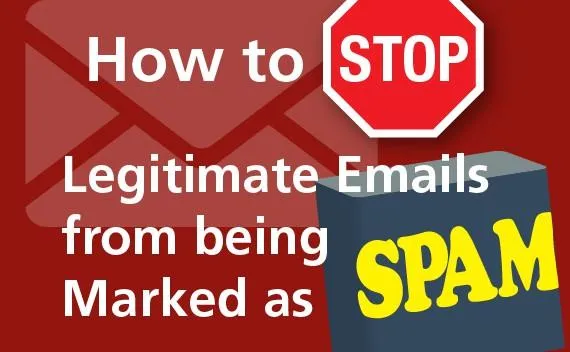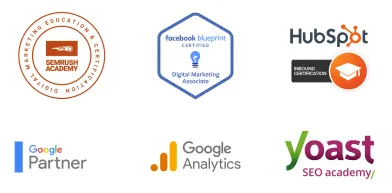TO LEARN IS TO GROW
Learning Center
We do our research and publish our results. Should probably call this the Growing Center.


How to Stop My Legitimate Pop3 Emails from being Marked as Spam (solution)
If your business is facing the frustrating problem of having your company’s outgoing emails sent to customers getting labeled as spam then fear not, because you are not alone and there are a number of steps you can implement now to help reduce the impact of this common issue.
Since people have grown tired of constantly being inundated with spam in their inboxes, filters, and various email spam programs have been created to reduce the volume of spam an email account receives by only receiving emails which meet a strict criteria; consequently, many of the emails sent by companies to their customers get labeled as spam. While there is no way to completely circumnavigate all spam filters, there are things you can do to make it more likely for your emails to be sent to your customers without being labeled as spam.
Take a look at the list of ways to stop your emails from being labeled as spam below.
Comply with the CAN-SPAM Act: This act requires that emails sent with anything commercially related must meet certain standards, mainly that they do not have misleading information in the header and subject lines, and that they identify themselves as an ad.
Try to stay away from spam trigger words and phrases that are commonly identified by filters as spam or phishing emails: Avoid words that are commonly in commercial advertisements and promotions, though even when you don’t use such words there is no guarantee that your email will avoid being labeled as spam.
When sending HTML emails, make sure to include a text version: Incorrect HTML tags can often cause emails to end up being filtered into spam
Consider requesting your customers to whitelist your domain: If your emails are getting blacklisted, then consider letting your customers/recipient know and asking them to place you on their “whitelist.”
Utilize some type of spam checking service: Before sending out emails to your client list, it is always a good idea to use a spam checking tool, such as the downloadable SpamAssassin, or online service that you send your email to, like com.
Make sure you aren’t on any blacklists: Check to see that your server isn’t on any blacklists that prevent your emails from being delivered spam-free; some free services include Free Email Blacklist Lookup at MX ToolBox, Email Blacklist Check, and Spam Database Lookup like info. If you find your server is on a blacklist, you need to follow up with the website you have been blacklisted why and correct the problem that had you blacklisted in the first place.
Avoid sending large attachments and certain types of attachments: As a general rule, you shouldn’t send emails with attachments to people on your list who are not expecting them. If you must send a particularly large attachment, try doing so using a service like com. Also, avoid sending .exe, .zip, and .swf attachments.
Investigate the reason behind every email bounce: Each time email bounces, it will indicate the reason, and once you know if someone has blacklisted you because you are sending spam, you can correct the problem.
Limit a number of emails you are sending per hour. If you are sending too many emails per hour, incoming servers will assume you are a spammer and you will be placed on blacklists. You should not be sending more than 20 emails per hour as a server. If you want to send out more than 20 emails per hour then we recommend using email marketing programs such as Constant Contact, etc. LOJO also offers email marketing options that are competitive and hassle-free.
There are many other small things you can be doing to avoid being blacklisted. If you have been blacklisted and your email is getting labeled as spam, give LOJO a call. We are happy to help you navigate through this issue.
Written by Cassandra Sohn
Built for Growth. Backed by 25 Years of Trust.
For over two decades, LOJO has been a trusted partner to hundreds of businesses just like yours. Whether working directly with owners, managers, teams, or boards of directors, our goal remains the same: to be a reliable and results-driven asset to your business.
Over the years, we’ve carefully built a team of experts—each selected for their unique skills, strengths, and personalities. Our clients choose LOJO because they know we genuinely care about their success.
And after 25 years of helping businesses grow, we’re more committed than ever.



Built for Growth. Backed by 25 Years of Trust.
For over two decades, LOJO has been a trusted partner to hundreds of businesses just like yours. Whether working directly with owners, managers, teams, or boards of directors, our goal remains the same: to be a reliable and results-driven asset to your business.
Over the years, we’ve carefully built a team of experts—each selected for their unique skills, strengths, and personalities. Our clients choose LOJO because they know we genuinely care about their success.
And after 25 years of helping businesses grow, we’re more committed than ever.




Matthew Rogers, President
iProspect Check
After spending several months reviewing multiple proposals from several different companies we engaged LOJO to develop a new website that represents our company effectively. We worked initially with Stephen Platte who helped create the scope of the project. Stephen was knowledgeable and always followed up with me on time and as promised.
He "closed the deal" for LOJO with his professionalism, service orientation and easy going approach. Once we signed the contract we were introduced to Jay Kelly who would be the creative lead for LOJO. This was the most challenging part of the project for my company, as there was no shortage of ideas from our side. Jay managed the project flawlessly, and once we had all agreed to the design, Jay introduced us to Eric.
Eric Lay is one of the founders of LOJO. Eric took the design we had developed and brought it to life. We delivered content as quickly as he requested it. Eric kept the project on task and we responded by exceeding every deadline for content. In turn, once provided, literally not a day went by that Eric didn't add the content and take the next step. In just a few weeks we launched our new website. Eric is a pleasure to work with.
His positive attitude and consultative approach really enhanced the experience and made a big difference for us in the outcome of our project. We would welcome you to visit our website to take a look at the quality work of LOJO. We are very pleased with LOJO and look forward to working with them in the future as we pursue an aggressive SEO strategy."
After spending several months reviewing multiple proposals from several different companies we engaged LOJO to develop a new website that represents our company effectively. We worked initially with Stephen Platte who helped create the scope of the project. Stephen was knowledgeable and always followed up with me on time and as promised.
He "closed the deal" for LOJO with his professionalism, service orientation and easy going approach. Once we signed the contract we were introduced to Jay Kelly who would be the creative lead for LOJO. This was the most challenging part of the project for my company, as there was no shortage of ideas from our side. Jay managed the project flawlessly, and once we had all agreed to the design, Jay introduced us to Eric.
Eric Lay is one of the founders of LOJO. Eric took the design we had developed and brought it to life. We delivered content as quickly as he requested it. Eric kept the project on task and we responded by exceeding every deadline for content. In turn, once provided, literally not a day went by that Eric didn't add the content and take the next step. In just a few weeks we launched our new website. Eric is a pleasure to work with.
His positive attitude and consultative approach really enhanced the experience and made a big difference for us in the outcome of our project. We would welcome you to visit our website to take a look at the quality work of LOJO. We are very pleased with LOJO and look forward to working with them in the future as we pursue an aggressive SEO strategy."

Matthew Rogers, President
iProspect Check
The team at LOJO were wonderful to work with. They are well organized and very patient as we worked through our marketing strategy and developed a well thought out and clear action plan at a reasonable price. We will definitely be back for our future campaign needs."

Jon Crosby, Founder
Dazil

